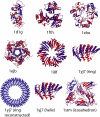Prediction of the structure of symmetrical protein assemblies
- PMID: 17978193
- PMCID: PMC2077069
- DOI: 10.1073/pnas.0702626104
Prediction of the structure of symmetrical protein assemblies
Abstract
Biological supramolecular systems are commonly built up by the self-assembly of identical protein subunits to produce symmetrical oligomers with cyclical, icosahedral, or helical symmetry that play roles in processes ranging from allosteric control and molecular transport to motor action. The large size of these systems often makes them difficult to structurally characterize using experimental techniques. We have developed a computational protocol to predict the structure of symmetrical protein assemblies based on the structure of a single subunit. The method carries out simultaneous optimization of backbone, side chain, and rigid-body degrees of freedom, while restricting the search space to symmetrical conformations. Using this protocol, we can reconstruct, starting from the structure of a single subunit, the structure of cyclic oligomers and the icosahedral virus capsid of satellite panicum virus using a rigid backbone approximation. We predict the oligomeric state of EscJ from the type III secretion system both in its proposed cyclical and crystallized helical form. Finally, we show that the method can recapitulate the structure of an amyloid-like fibril formed by the peptide NNQQNY from the yeast prion protein Sup35 starting from the amino acid sequence alone and searching the complete space of backbone, side chain, and rigid-body degrees of freedom.
Conflict of interest statement
The authors declare no conflict of interest.
Figures





References
-
- Goodsell DS, Olson AJ. Annu Rev Biophys Biomol Struct. 2000;29:105–153. - PubMed
-
- Stefani M, Dobson CM. J Mol Med. 2003;81:678–699. - PubMed
-
- Eisenstein M, Shariv I, Koren G, Friesem AA, Katchalski-Katzir E. J Mol Biol. 1997;266:135–143. - PubMed
-
- Berchanski A, Eisenstein M. Proteins. 2003;53:817–829. - PubMed
-
- Berchanski A, Segal D, Eisenstein M. Proteins. 2005;60:202–206. - PubMed
Publication types
MeSH terms
Substances
LinkOut - more resources
Full Text Sources
Other Literature Sources
Molecular Biology Databases

